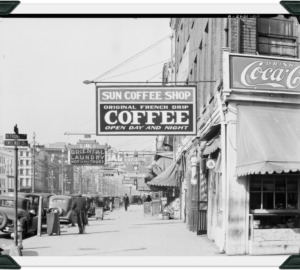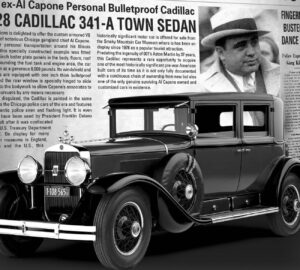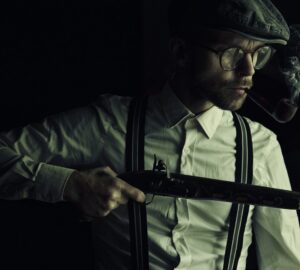Many techniques are used to add extra tension to movies in our favorite movies, with some of them being so subtle that we barely notice them. The following are a few examples of how directors crank up the tension as much as possible when villains and mobsters appear, in a variety of highly effective ways.
The Use of Dramatic Music and Leitmotifs
We all know that music is a huge part of the cinematic experience, but there may be times when you don’t even notice how big an effect it has on you. 1960’s Psycho is one of the greatest examples of using music to add drama. Director Alfred Hitchcock initially wanted a more modern, jazz soundtrack but ended up defining the slasher movie sound with a sparse musical backdrop that is terrifying in all the right places.
The original Star Wars movie in 1977 took a different approach. John Williams composed all of the music for this franchise up until 2018’s The Rise of Skywalker. One of the ways that he added tension was by creating a leitmotif for the main characters, so you know right away that something bad is likely to happen when you hear the sound associated with Darth Vader.
Francis Ford Coppola brought the Mafia to the attention of millions of people with his Godfather trilogy and the 1972 Godfather soundtrack is perhaps the other greatest example of music adding tension to a movie. Italian composer Nino Rota added an authentic Italian atmosphere and an instantly recognizable main theme that mixes nostalgia and a vaguely threatening feel. Sadly, he missed out on an Academy Award as his nomination was disqualified because part of the music had already been used in 1958’s Fortunatella.
In fact, if you watch the Godfather movies, you will see how the music adds to each of the most important scenes. The haunting trumpet represents Vito and it tells us that he is present or about to appear. Take out the music and it would still be a great movie, but it would undoubtedly lose some of its edge.
Location, Location, Location
Bond introduced us to the glamor and dangers of life as an international spy, traveling all over the world in order to do so. In fact, there are even stories of Bond actors involved in real-life moments as tense as the carefully crafted movie scenes. But there’s one type of venue he regularly attends that draws the audience to the edge of their seats: he is regularly found saving the day in a casino. In the 2006 movie Casino Royale, the main drama comes from the Texas hold’em tournament that sees Bond pitched against Le Chiffre. This game ends in a hand with $115 million in stakes, that the bad guy thinks he has won with a hand packed with 6s and aces. However, Bond has a straight flush, meaning that he knew all along that he was almost certain to win. A royal flush could have beaten him, but the probability of getting this hand in a game of poker is 0.00015%. The director added more tension by having 007 lose the first hand, and by putting an action sequence in the middle of the game.
007 makes another appearance at a casino table in License to Kill, as he turns to blackjack this time. Timothy Dalton is the famous agent in this 1989 movie, and he makes his appearance in a luxurious casino asking for a private blackjack table. The spy shows his knowledge by using tactics like double down and split, eventually walking away with a quarter of a million dollars from the villain’s casino while the bad guys can only watch him.
Bond plays baccarat in other movies, and this appears to be his favorite game. Yet, the more modern versions often have him playing Texas hold ’em, which is perhaps a reflection of how poker has become wildly popular in recent years. This may change in the future, as online betting has allowed players to discover new games. Andar Bahar is among the names with which people visiting live internet casinos with human dealers are becoming increasingly familiar. This is a card game from India where the Andar bet has a 51.5% chance of winning and the Bahar wager 48.49%. Another exotic game that could become popular is Dragon Tiger, which is also popular in Asia. Whether we eventually see these card games crop up in future Bond films remains to be seen, but the tension they could bring to a Bond game is as palpable as with the card games that have already graced our screens.
Foreshadowing Builds Up the Tension
Foreshadowing is a cinematic technique that allows the director to show us what is going to happen later. It made be a clue hidden in the dialogue, or it could be an image that gives us a hint at what will happen next.
1942’s Casablanca is one of the most-watched and most-loved movies in history. Part of this is due to the fact that, by 1977, it was the film that was shown most regularly on American TV channels. Yet, at the time of filming it, there were serious doubts about how successful it would be. One of the problems during production was that Ingrid Bergman (Ilsa) was two inches taller than Humphrey Bogart, who played Rick. Another was that the screenplay for the movie, due to be called Everybody Comes to Rick’s, was still a work in progress when filming began. Yet, it won several Oscars and turned Bogart into the planet’s highest-paid actor. And while most of us can quote several lines from the movie, there is some foreshadowing that not everyone notices. For example, when the cold and distant Rick is moved by the plight of two Bulgarian immigrants and helps them to get the money they need to escape Europe, letting us know that his love for Ilsa will eventually win out and see him help her to escape the Nazis.
Perhaps the greatest example of foreshadowing is the Usual Suspects. This clever 1995 film shows us lots of little clues during Verbal Kint’s interrogation, such as the gold lighter and the bottom of the cup. All of this adds to the feeling that you should have known who Keyser Soze was all along, and makes re-watching it a genuine pleasure too, as we spot the clues and foreshadowing that we missed the first time.
You might not think that more tension is needed when we see villains like those in the infamous Mafia, but these examples have shown us that the big-screen action can be even more exciting when certain techniques are used.
- Online casino’s safeguards against crime - January 8, 2025
- The Best Slot Games For Low-Budget Play - December 14, 2024
- From Mob Mentality to Digital Thrills - December 10, 2024








